How 8 contemporary artists are exploring the climate change crisis
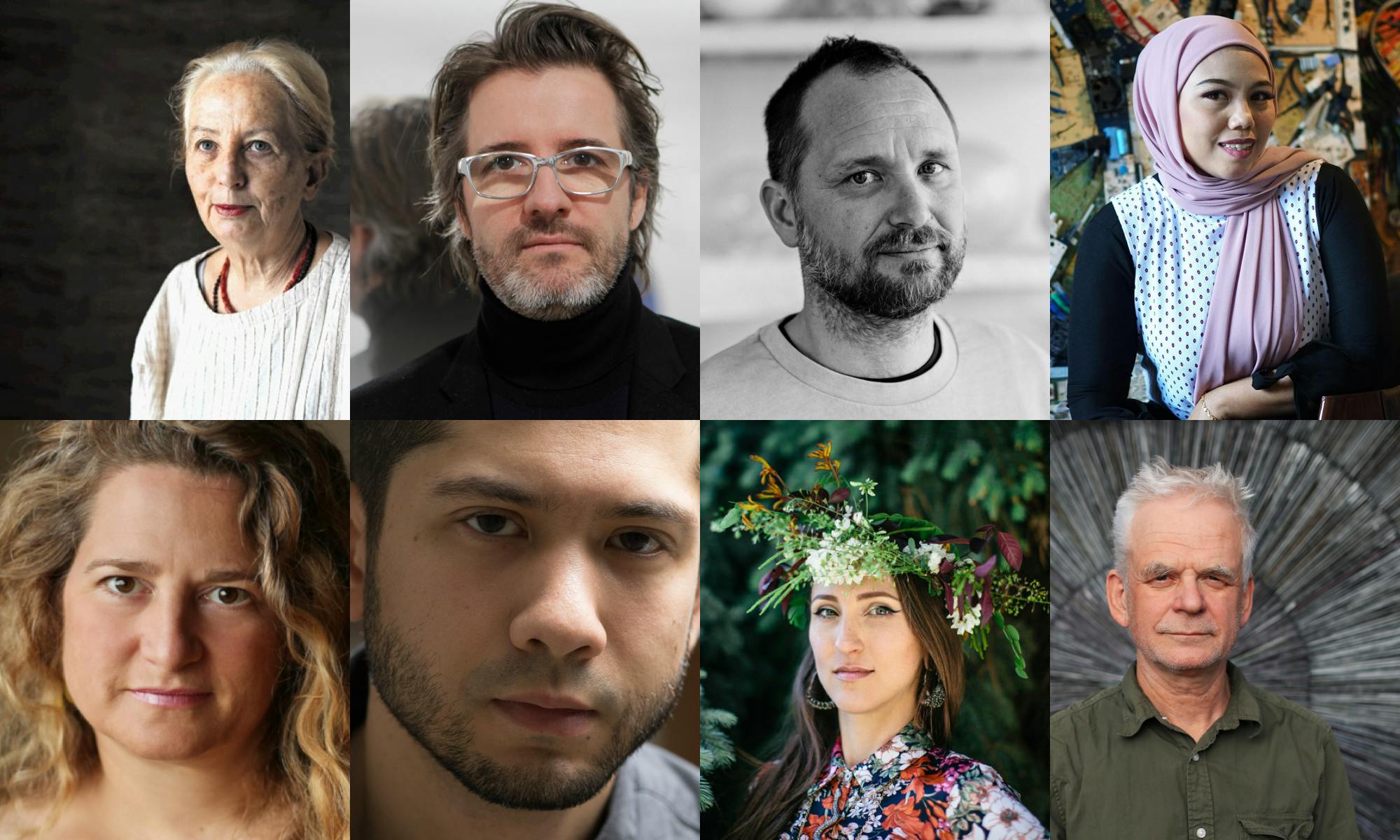
Since the very origins of art, nature has been a constant source of inspiration. Over the last few decades, due to growing concerns of climate change, artists have been increasingly creating works intended to raise public awareness towards the many ecological perils that populate our aching world. This post explores how some contemporary artists are tackling this pressing issue that is impacting our daily lives.
The development of environmental or ecological art
Climate change has always been around. However, the present state of global warming plays a significant role in climate change because it’s the main result of human activity. Melting glaciers, wildfires, hurricanes, coastal erosion, agriculture depletion, flooding, and the extinction of various animal species are just a few of the countless consequences of this crisis, explained Lauren Godfrey in her thesis titled Climate Change and Contemporary Artists.
Within the cultural arena, although the origins of ecological or environmental art, which targeted issues regarding the environment, ecology, and sustainable development, began in the 1960s and continued in the following decades, this type of art acquired wide popularity till the 21st century when there was a rise in environmental concerns and when different scholars theorized on the causes and effects of climate change. For example, during this time the term Anthropocene, referring to an unofficial geologic era marked by the impact of human activity on earth, began to inspire the work of artists and curators, as explained by National Geographic.
Nowadays, contemporary artists use a wide variety of mediums, ranging from painting and drawing to large-scale transdisciplinary installations and public art projects, to explore these issues. Below we mention only a handful of the many contemporary artists working with these subjects. We purposely selected emerging, mid-career, and well-established artists working with different mediums, materials and disciplines as a way to evidence the diversity of approaches towards these issues.
Marjetica Potrc
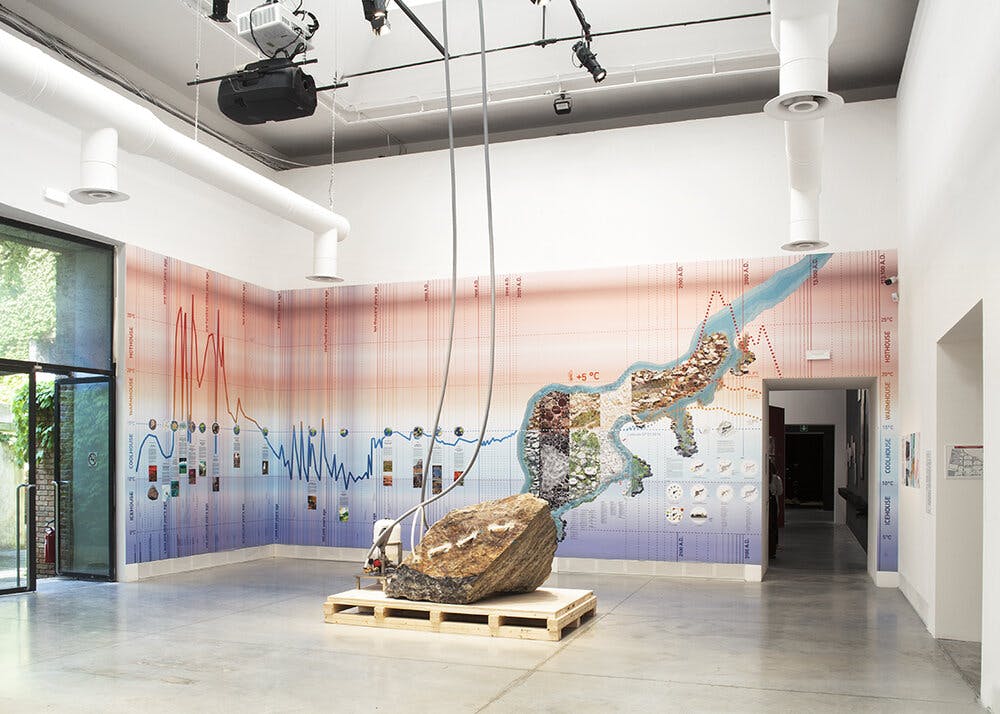
Marjetica Potrc is a Slovenian artist and architect (1953), whose practice incorporates architecture, visual art, and social sciences as a means to create complex installations that frequently analyze humanity's need for shelter and the ways in which people live together. As Lauren Godfrey explained, in some of her works, the overarching theme of climate change is present through the conceptualization and execution of sustainable architectural solutions for communities that are negatively impacted by the effects of climate change or will be affected in the future.
For example, in the transdisciplinary project titled Future Island, which was exhibited at the 17th International Architecture Exhibition – La Biennale di Venezia, the artist and OOZE Architects (Eva Pfannes and Sylvain Hartenberg) produced a living artwork and a scientific endeavor– an island that evolves over time showing how nature is affected by climate change. The experimental project, presented in the section titled As One Planet, captured in miniature, through architecture, the planet’s response to climate change. “More than just a preliminary tool for measuring adaptive behaviors, the project uses simulation to create a shared imaginary of our possible future,” Public Art Agency Sweden said about the piece.
Olafur Eliasson
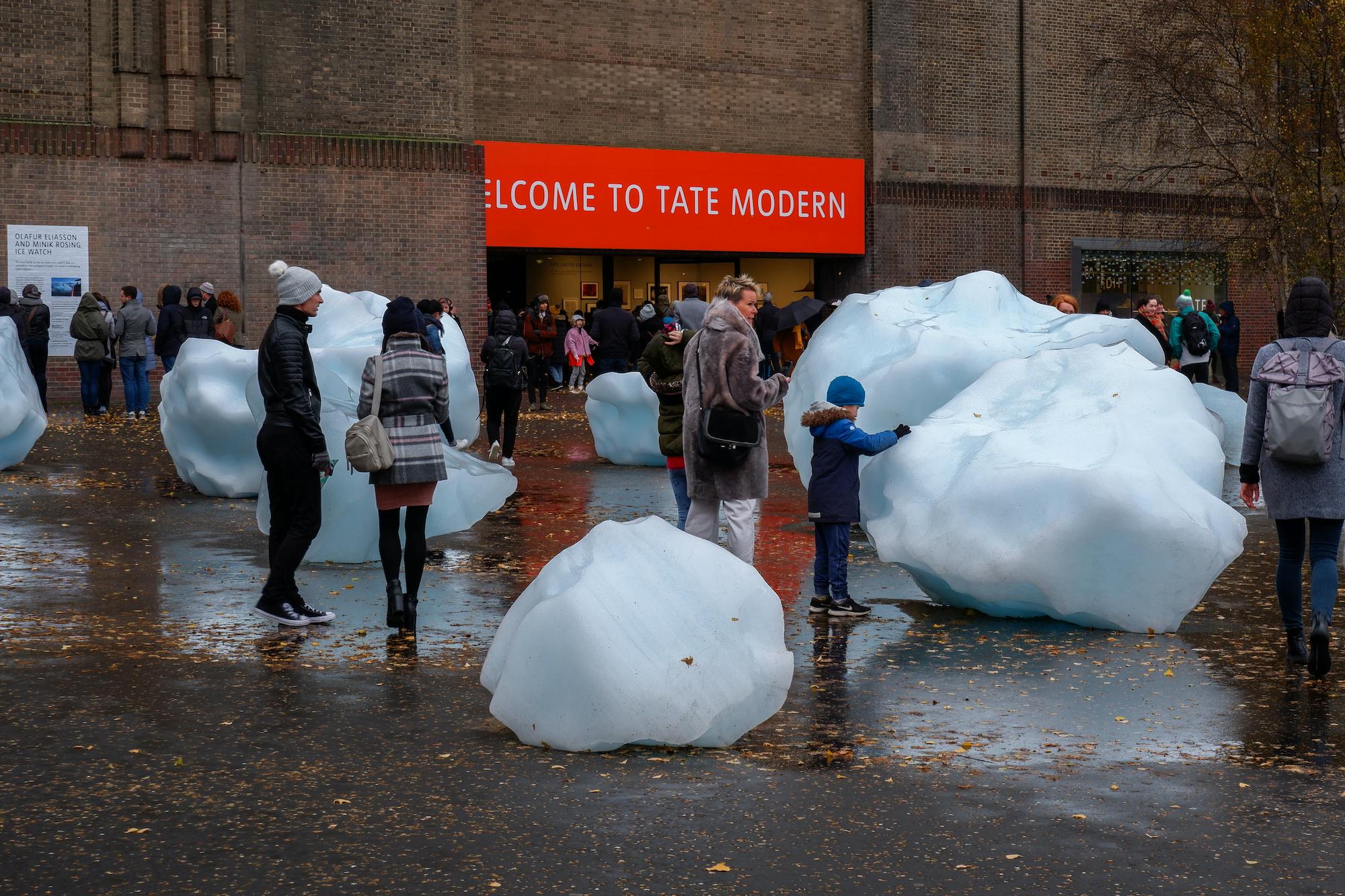
Danish-Icelandic artist Olafur Eliasson (b.1967) is one of the world’s most renowned ecologically conscious artists, who for years has been producing a myriad of large-scale works and projects inspired by environmental issues many of which are ephemeral or interactive and deal with light or water. For instance, as stated in an Art in America article, in 2014 Eliasson and his collaborator, geologist Minik Rosing, shipped blocks of ice cast off an ice sheet in Greenland to a public square in Copenhagen and then replicated the project in London and Paris. Titled Ice Watch, the work intended to raise awareness of climate change by providing an experience of the reality of melting arctic ice. This work created a dramatic and powerful yet ephemeral contrast between the bustling life of an urban city and the aching natural landscape.
Importantly, next to his artistic practice, Olafur has also been appointed as Goodwill Ambassador for climate action by the United Nations Development Programme and has continued his role as an advocate for urgent climate action. At the same time, he has also created ecological companies such as Little Sun, a solar energy company whose mission is to displace fossil fuel lighting in communities living without electricity and to raise awareness of energy access and climate action, reported Artsy.
Tomás Saraceno
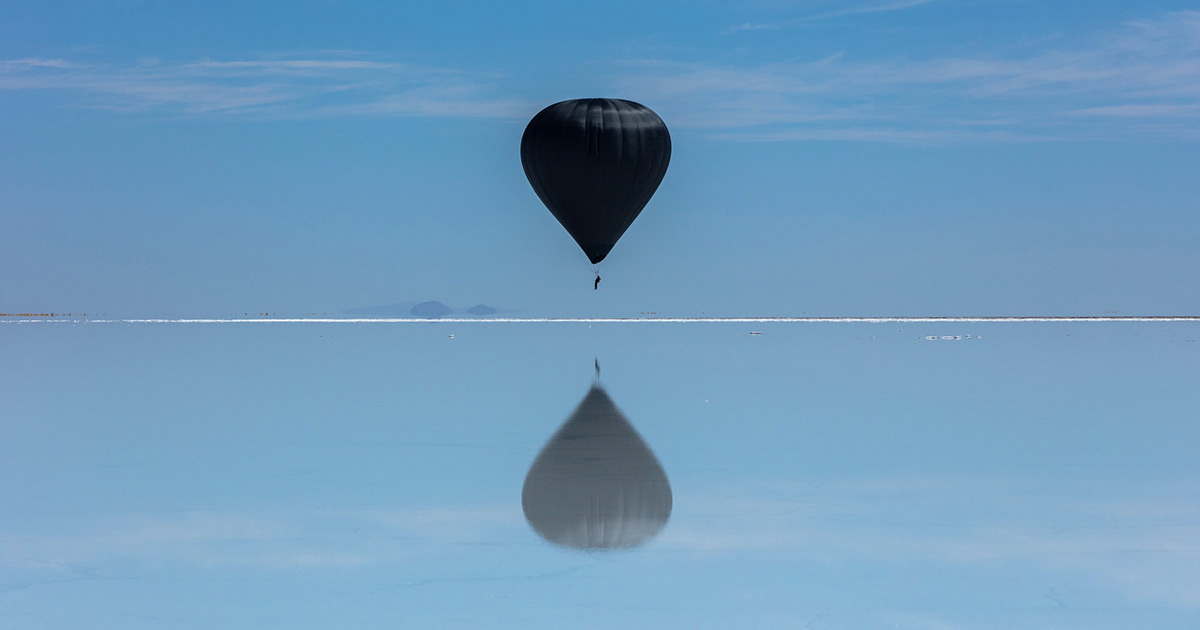
For years Saraceno (b. 1973, Argentina), a trained architect, has imagined better ways in which humanity will be able to live. His utopian visions have resulted in widely-acclaimed transdisciplinary artistic projects which involve art, science, architecture, and sociology. One of his main sources of inspiration is the spider and the entangled yet perfectly logical networks of its webs. As proof of this, over the past decade, the artist has been working on the project Aerocene (2015–present), in which he has worked with an international community of artists, scientists, and thinkers joined together by their intention of creating fuel-free life in the atmosphere. Through this initiative, described in the project’s website “as an interdisciplinary artistic community that seeks to devise new modes of sensitivity, reactivating a common imaginary towards an ethical collaboration with the environment and the atmosphere, free from carbon emissions,” Saraceno has produced floating, solar-powered museums made of recycled plastic bags (Museo Aero Solar, 2007–present), and in 2015, the group also broke a world record for the first and longest fully solar-powered flight.
Importantly, last year, Saraceno was one of the six artists commissioned by the state of California to create the world’s largest permanent public art installation which revolves around climate change. The installations were slated to start being displayed in late 2021 but have been delayed, reported ArtNet News. Once finished this project will showcase works by Saraceno, Allora & Calzadilla, Refik Anadol, Kameelah Janan Rasheed, Noé Montes, and Andrea Polli.
Nor Tijan Firdaus
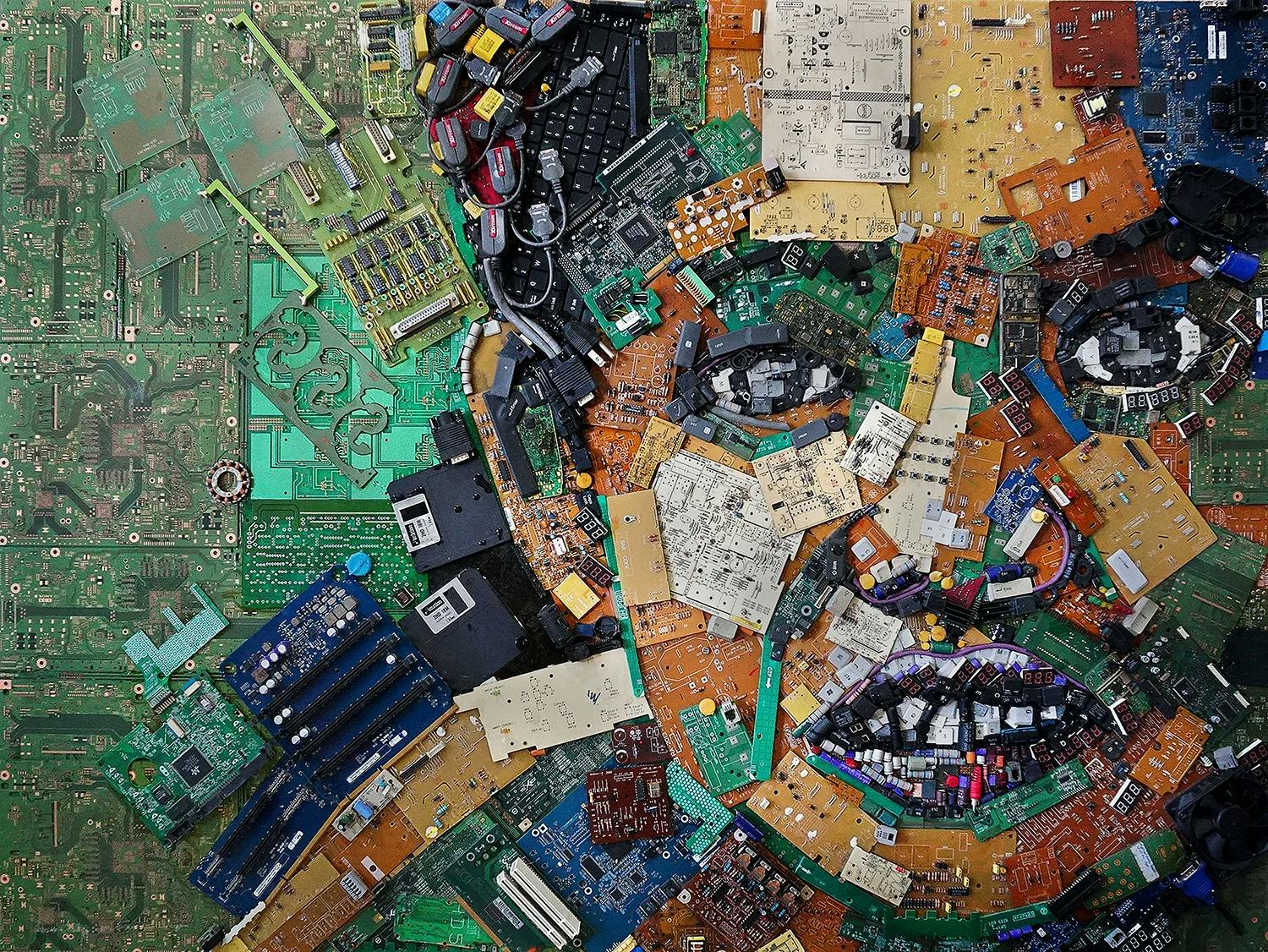
Malaysian emerging artist Nor Tijan Firdaus, (b. 1986, Klang, Malaysia) gathers e-waste, such as electronic components from resistors to transistors and inductors, and uses them as the main components of her figurative and detailed two-dimensional yet highly textural works. Her selection of materials intends to bring to light climate change, biodiversity loss, and environmental degradation concerns. In the past, she has used these discarded materials to recreate iconic artworks. Among her most popular pieces are her recreations of famous artworks, like Johannes Vermeer’s Girl With The Pearl Earring, Gustav Klimt’s The Kiss, Henri Matisse’s The Amber Necklace, and Vincent van Gogh’s Starry Night. At the same time, in other works, like Climate Change is Real (2020), the artist presented a portrait of a child as a means to evidence how society’s present actions will impact future generations. Given the nature of her works, her process involves the detailed cleaning and detoxification of these electronic components, reported The Artling.
Stacy Levy
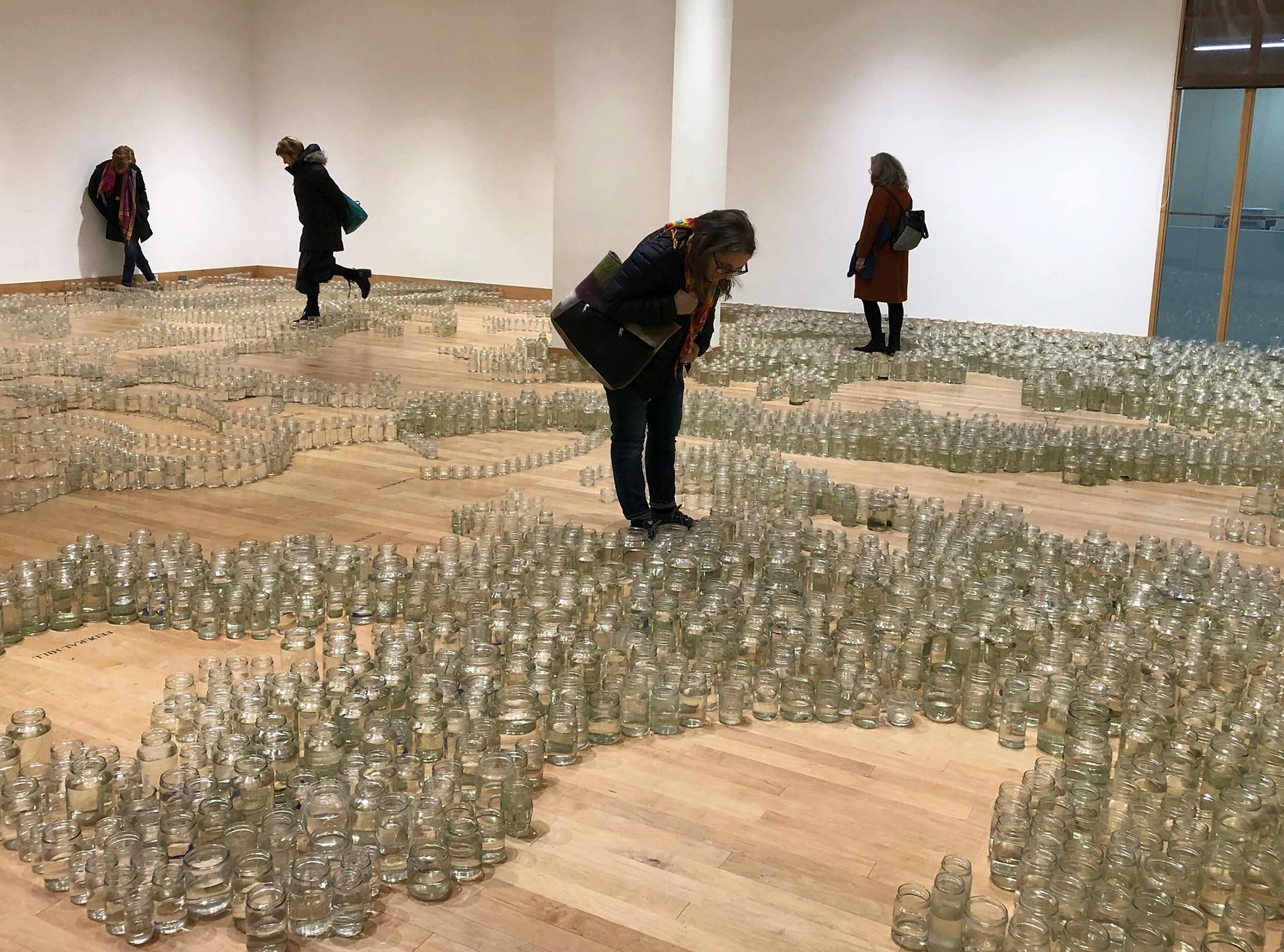
Stacy Levy (b.1960) is an American eco-artist who creates large-scale public installations in rivers, streets, parking lots, airports, and nature centers merging the disciplines of art, ecology, science, and collaborative engagement. In her large-scale sculptural works, she frequently uses water and water flows as her primary material for addressing ecological degradation and environmental issues. Levy’s artistic projects are often closely connected to the specific environment in which she places them in.
One of her latest works is Collected Watershed, displayed in 2020 at the Center for the Arts Gallery at Towson University in Towson, Maryland. The project is a live map made of 8,500 recycled jars, filled with water collected from thousands of local waterways by a team of Towson University students and faculty members who accompanied the artist and used USGS maps to seek out hard-to-find suburban and urban streams, runs, and creeks. The installation aims to bring to the forefront waterways that are often hidden and forgotten yet, as the artist said, carry “the lifeblood of our planet” and must be remembered and protected. This aligns with the artist’s statement: “In my practice, I search for sites that provide the opportunity to make visible some of the forces at work on the site. Interested in watersheds, tides, growth, and erosion, I make projects that show how nature functions in an urban setting.”
Michael Wang
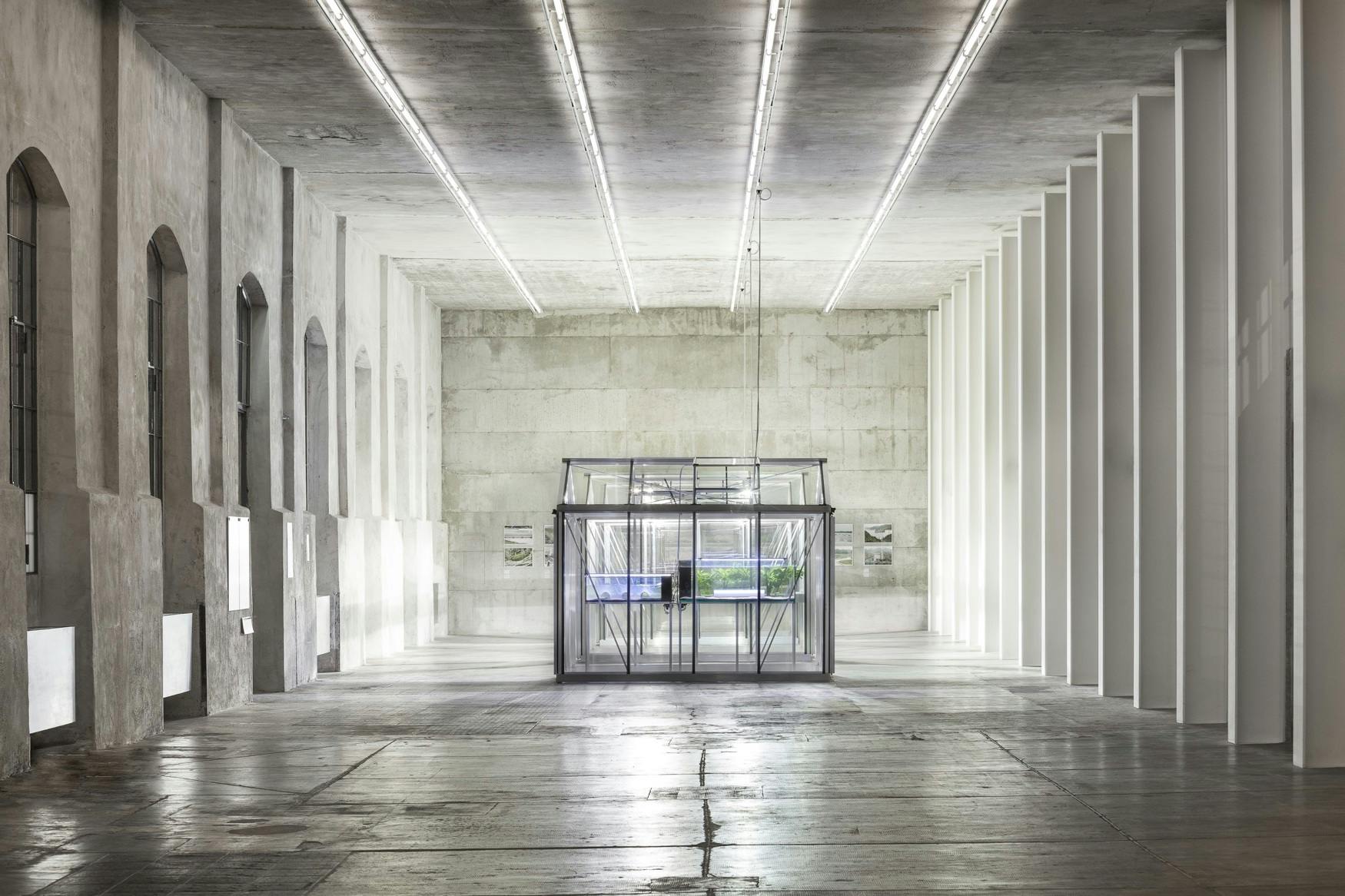
Some artists, like New York-based Michael Wang (b. 1981), have investigated the ecological blind sports of the art system. As Art in America explained, the global art system by itself is carbon-intensive: “shipped around the world to venues that art world nomads fly to visit, activist climate art often risks unintentional irony with the emission-producing transport it entails.” A few years ago, Wang, who often creates artworks and projects that explore environmental issues, started creating cube-like minimalist sculptural representations of the amount of carbon dioxide generated in the production of twenty famous contemporary artworks. In the artist's words: “My work emerges at the intersection of an art object and larger external systems. In the ongoing series Carbon Copies, I link the production of artworks to the release of greenhouse gasses, calculating and sculpting the invisible carbon footprints of recent well-known artworks.”
However, recently the artist has created other projects, like Extinct in the Wild, which focuses on flora and fauna which can no longer be found in nature but persist exclusively in cultivation or captivity hence requiring human intervention for remaining alive. Part of this project was Extinct in New York, where, as he explained in an interview with Art of Change 21, the artist exhibited plant, algae, and lichen species that are known historically from New York City but are no longer found growing wild in the city. He spent a year growing around fifty of these species in his studio garden and after the exhibition, on Governor’s Island in New York, the plants were distributed to city parks.
Jennifer Kendler
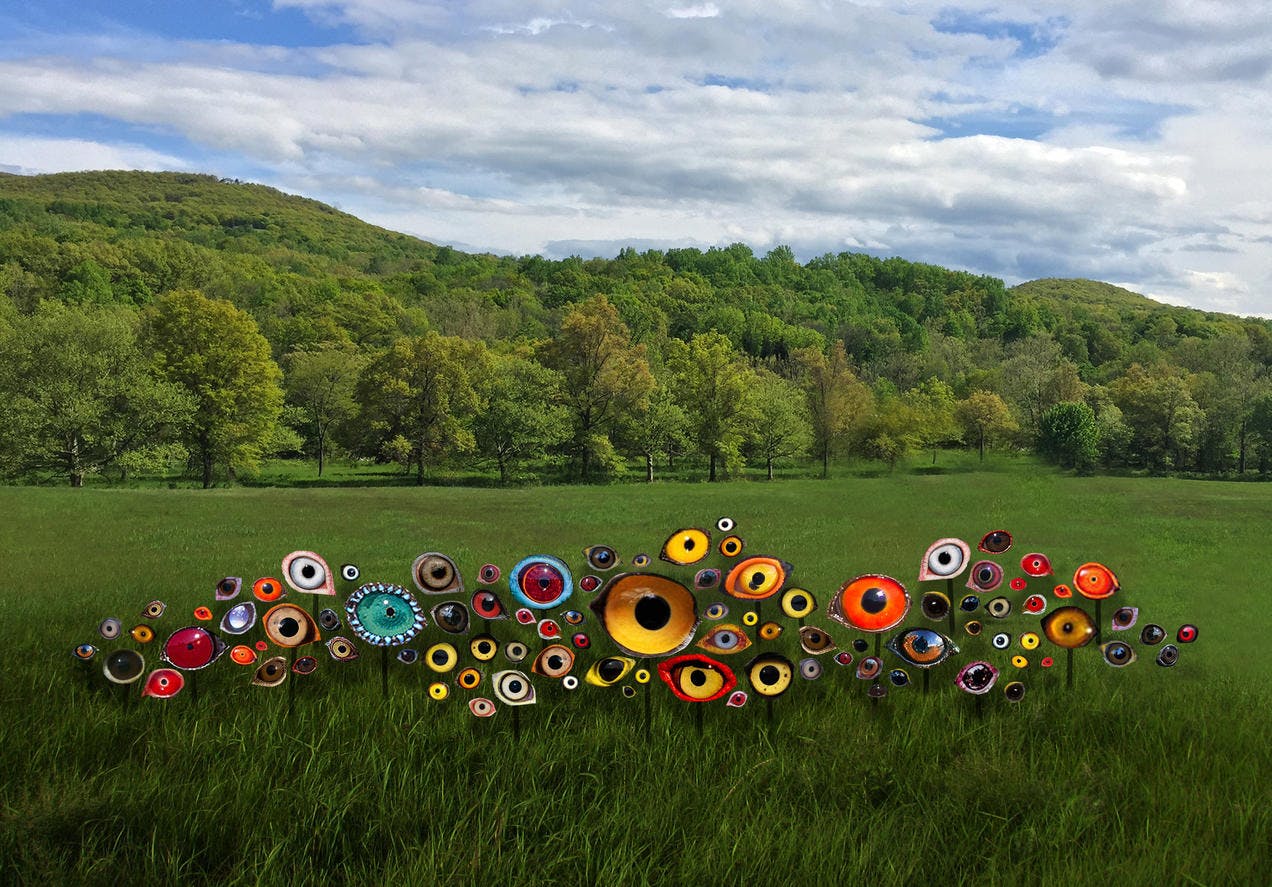
Jenny Kendler (b. 1980, New York City) is an interdisciplinary artist, environmental activist, and naturalist who lives in Chicago and various forests. One of her latest projects is Birds Watching, a 40-foot long sculpture composed of a “flock” of one hundred reflective bird’s eyes mounted on aluminum. Each “eye” is representative of a species of bird threatened by climate change within the United States, which are illuminated when hit with light. This piece, which makes us remember the precious species humankind is about to lose, was created for Storm King’s Indicators: Artists on Climate Change, and was then shown on the elevated 606 Bloomingdale Trail in Chicago, Illinois (until December 2021). As stated on the artist’s website, “...within the gaze of these many others, the work asks us to consider our responsibility for climate change’s myriad effects on other beings…Birds Watching reminds us that when we look at nature, nature looks back.”
Andy Goldsworthy
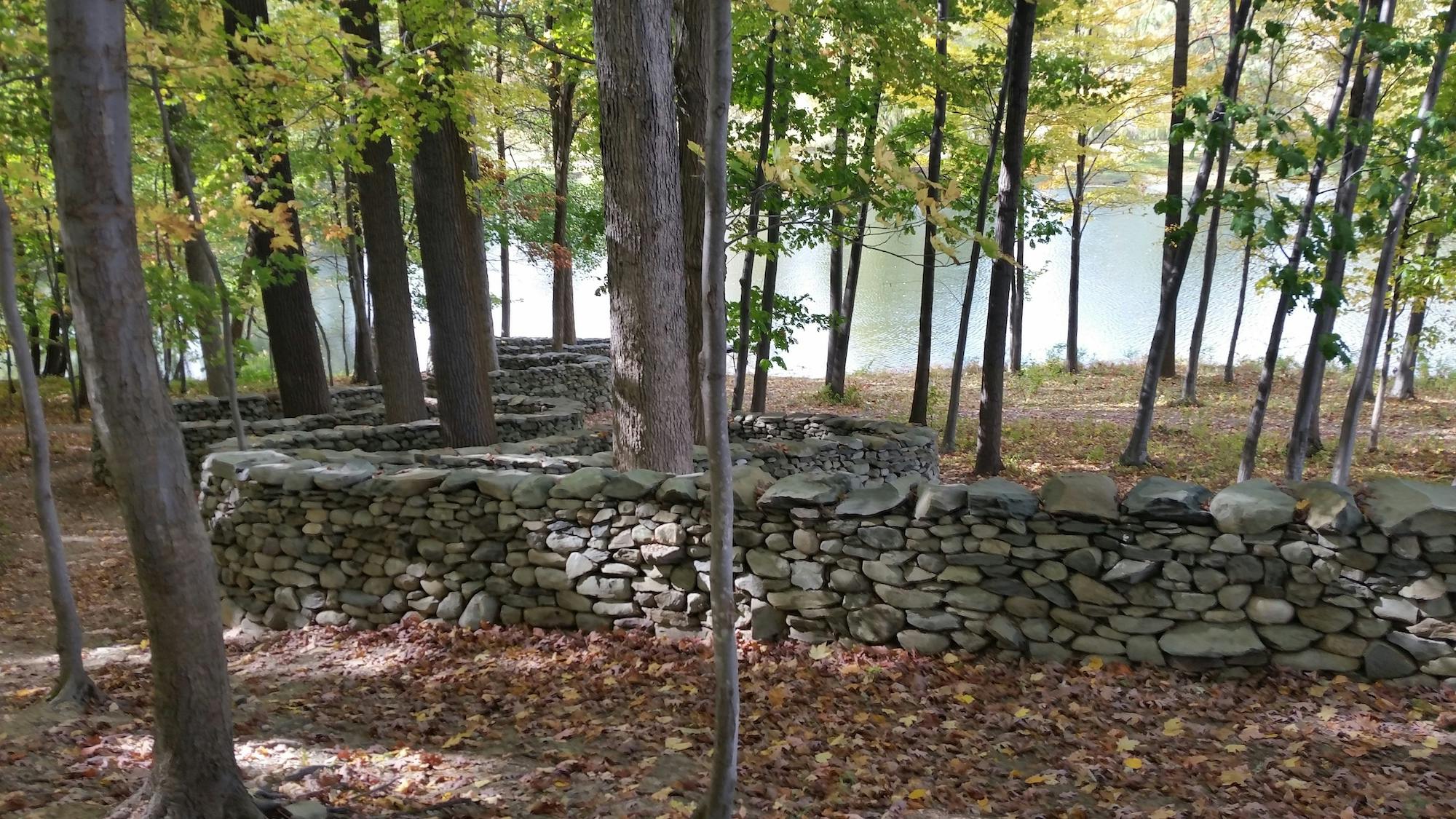
For decades, British sculptor and photographer Andy Goldsworthy (b. 1956) has been one of the environmental art movement’s most prominent figures. Goldsworthy frequently uses nature by itself as his main material for his works. In this way he has created sculptures out of snow, ice, wood, and mud, meaning they are often ephemeral. “It’s not about art,” he once explained, “It’s just about life and the need to understand that a lot of things in life do not last.” Nonetheless, he has also produced a good number of permanent works like Storm King Wall, 1997-1998, a 2,278 feet wall of rocks snaking through the woods at Storm King, a 100-acre outdoor museum located in New York’s Hudson Valley. Also, on the occasion of Storm King’s fiftieth anniversary in 2010, Goldsworthy returned to Storm King to build Five Men, Seventeen Days, Fifteen Boulders, One Wall in a field that had interested him upon his first visits to the area. In this project, he and a team of wallers altered a 309-foot dilapidated wall over seventeen days to create a structure resembling an ancient ruin.
At the same time, as Artsy described, Goldsworthy reimagines existing environments: rearranging fallen logs as lines formed through a forest or creating starbursts exclusively from icicles and spit.However, next to his prevalent use of organic elements, on occasion, the artist has also reutilized other sorts of materials to highlight issues related to the environment. For example, in a recent exhibition organized by San Francisco-based FOR-SITE Foundation at the city’s historic Cliff House, the artist pointed out California’s ongoing drought with Geophagia (2021), a set of salvaged restaurant tables covered in cracking white clay from the Central Valley.